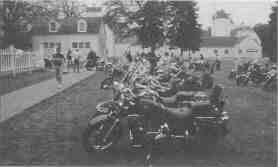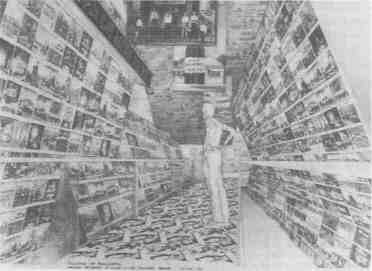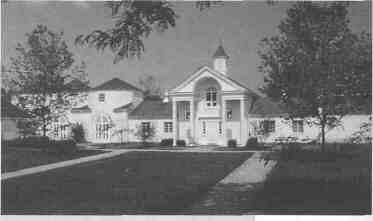SPECIAL FOCUS
One Foot in Scholarship,One Foot in Disney
Entrepreneurs in museum management design exhibits that are exciting,
interactive and "cool," with a marketing and sponsorship hook
BY JANET L. GALLIMORE
A steadfast hold solely on scholarship will lose a
museum in today's crowded leisure marketplace.
Museums and their managers instead are challenged
to embrace a marketing mind-set to pull in patrons,
keep them active and intrigued, then bring them
back.
|

Photo: The second annual Fall
Heritage Run, a motorcycle
tour of historic destinations in
Lake County, continues to be a
fun and compelling way to
attract nontraditional visitor
attendance to
the Lake County
Museum. Photograph by Kim
Karpeles.
|
Nowhere was this more mandated than at the
1991 annual meeting "Forces of Change" of the
American Association of Museums (AAM). There the
AAM presented "Excellence and Equity: Education
and the Public
Dimension of
Museums," a
position paper
on the need for
museums to be
both stewards of
professional
excellence and
responsive to the
public. "Excellence and
Equity" challenged American
museums to reconsider their roles in a rapidly changing world. Public museums, such as those operated by
park and forest preserve districts, as well as private
museums must reconsider and shape their roles for the
future.
For some time, museums have enjoyed an "entitlement" existence. They are the keepers of cultural and
natural heritage and are important because they
improve the quality of life in communities. Museums
hold themselves accountable to strict standards in
collections care and scholarship. Because of their
educational missions, museums have long considered
their value to be evident.
|
However, increased competition for limited public
and private funds has challenged their sustainability,
and heightened public accountability has given cause
to question their relevance to the communities served.
How has this affected museum management?
Certainly, museums have had to transform the way
they operate, reorganize staffs, and reconsider
"products" in light of audience needs. Performance
indicators such as increased attendance, earned
revenues, and community support have become as
important as the quality of programs and services.
Many museums have adopted private sector
business processes to assist in their operations.
Language such as "scenario-based planning," "data
modeling," "performance benchmarks," and "cost-
benefit analysis" would have been relatively unheard of
in museum conversations ten years ago.
The roles of staff and volunteers have changed,
along with allocation of staffing to specific museum
functions. There is a higher expectation of staff to be
mindful of the public they serve, to share in the
responsibility for the success of the entire organization, and to adopt an entrepreneurial mind-set,
recommending and implementing new practices that
advance the goals of the institution while saving
resources.
Use of focus groups and demographic surveys have
supplemented staff recommendations for new
exhibits, programs, and services. A shift to a market
36/ Illinois Parks and Recreation
orientation and awareness of competition for people's
leisure time requires thinking that balances content
scholarship with a presentation akin to Disney.
The Lake County Museum, for one, has shifted to
this type of marketing mind-set. Located in the
northwest suburbs of Chicago, the museum is a
department of the Lake County Forest Preserve
District, which has faced significant change due to
the Property Tax Extension Limitation Act (or tax
cap). The tax cap imposed resource limitations that
forced the district and, thus, the museum to set new
institutional priorities. An expectation for the
development of non-tax revenue and increased use by
the public became a priority. The forest preserve's
board of commissioners and staff engaged in a process
that resulted in a revised mission and new strategic
plan that focused on the enhancement of the museum
for improved public access to its collections.
In order to reach its new goals, the museum had to
reallocate its internal resources and determine how it
could compete more effectively in the marketplace. A
reorganization dedicated more staffing to visitor
services and marketing. Consolidating collections and
archives staff focussed our vision for use of the
museum's historic resources.
In order to generate revenue, programs were
analyzed to determine their interest and value to the
market. Our programs are designed to be mission-
related, fee-based services with appeal for a broad
audience.
We have also been successful in promoting use of
our archives to for-profit clients such as a partnership
with Corbis in a licensing agreement for Internet
sales. Corbis is a privately owned company that
provides visual content and services to creative
professionals and images consumers through innovative digital technologies.
Similarly, we have expanded use of the museum
facility for weddings, birthday parries and business
meetings. Staff also has received nontraditional
training in areas of negotiation and revenue enhancement strategies.
The cornerstone of the museum 's strategy to be
more competitive in the marketplace is its "New
Exhibition Project." In 1999, the museum will unveil
6,000 square feet of spectacular, new exhibitions. The
forest preserve board concurred with the staff that the
museum's major public "product," its exhibits, had to
be compelling, exciting and fun if the museum were
to increase its audience and encourage attendance
from nontraditional visitors. At the same time, the
exhibits had to reflect the rich history of Lake County
and highlight the Museums Curt Teich Postcard
Archives.
|

Above: What do more than
one million images illustrating
more than 100,000 cities and
towns look like? The new
"Millions of Postcards" section
of the "Bringing the World
Home" exhibition of the Lake
County Museum is intended to
provide the general public
and tourists with access to the
nationally renown Curl Teich
Postcard archives. This and
other exhibits will open in late-1999. Drawing by Abrams,
Teller, and Madsen/EDE of
Chicago.
|
The museum started this project by getting ideas
from the community. Subject matter specialists from
area colleges and universities were invited to brainstorm how to make history more exciting and relevant to the general public. Focus groups were conducted
representing the museums target audiences of families
with children, primary and secondary schools and
tourists. To ensure inclusiveness, detailed dialogue
with the African, Hispanic, and Asian American
communities took place. And, for the "cool" factor,
fourth graders selected exhibit interactives. The
design/build firm of Abrams, Teller, and Madsen/EDE
of Chicago was asked to incorporate this input and
design exhibits that would be experiential and
exciting, have a marketing and sponsorship hook, and
be party proof.
|
American Demographics indicates that most people
shop in their leisure time, so the museums new
exhibit, the "Lake County Mall of History" will use
the popular cultural icon of the shopping mall to
organize and tell the comprehensive story of the
history and culture of Lake County. The design is
intended to appeal to both current patrons and visitors
who might have never before considered visiting a
museum.
For example, the "Nature Store," one of 11 exhibits
in the Mall of History will invite the visitor to "read"
the land and reflect on its history using the forest
preserve as a backdrop. "Bringing the World Home"
will present the history and significance of the picture
postcard, in the nation's only permanent exhibition on
this subject. The exhibit offers a new major tourism
attraction for Illinois and a way for the general
community to explore the richness of the Curt Teich
Postcard Archives.
These new exhibits involve the visitor directly,
emotionally, and experientially through real stories of
people of the past; offer information in a compelling,
January/February 1999 /37
|
The more passive
role of stewards of
memory has
expanded and
now even
embraces the
museum's role in
serious social
concerns such as
literacy and the
environment.
|
contemporary way; and are intended to expand the
museum's audience as well as change the public's
perception about history.
The American Association Museums (AAM) has
worked with the museum community to create tools
to assist organizations interested in implementing the
principles set forth in "Excellence and Equity." The
Lake County Museum served as one of 11 museums
selected nationwide in AAM's National Research
Demonstration Project to Expand Education in
American Museums. These 11 museums, along with
others, assisted in developing New Visions: Tools for
Change in Museums. The national accreditation
process now also assists museums in assessing how
well they address organizational development and meet
the needs of their communities.
Museum management has grown increasingly
complex. The more passive role of stewards of memory
has expanded and now even embraces the museum's
role in serious social concerns such as literacy and the
environment.
Why is this the business of a museum?
In his 1997 keynote address to the Midwest
Museums Conference entitled "No Magic Map,"
Robert R. Archibald, president of the Missouri
Historical Society, reflected: "Our old roles are
increasingly irrelevant to the needs of our communities. In the face of increased competition for philanthropic dollars and growing scarcity of public dollars
for services of all kinds, I don't think that dollars for
cultural activities are going to be easier to come by in
the future, unless we transform ourselves."
As we look toward the future, museums that are
prepared internally to embrace their role externally will
flourish, no matter what change awaits. •
JANET L. GALLIMORE
is the director of the Lake County Museum and vice president or the Association of
Midwest Museums.
|
|

|
About the Lake County Museum
|
The Lake County Museum collects, preserves, interprets, and presents the history and culture of Lake
County. Through its Curt Teich Postcard Archives, the museum provides access to the nations largest
collection of postcards and related materials which illuminate 20th century life.
The Lake County Museum uses the power if its object and archival collections in public programs of
education and preservation which foster an understanding of the history of Lake County, Illinois, and
its place in the world. The Museum's success and value are measured by the enjoyable learning
environment that we bring to our diverse community.
|
The Lake County Museum manages more than
18,000 objects and 10,000 archival items relating to
Lake County history. The Curt Teich Postcard
Archives, covering 1893-1978, is the largest public
collection of postcards and related materials in
North America with more than one million images
illustrating more than 10,000 towns and cities
alone.
A department of the Lake County Forest
Preserve District, the museum is located in a
40,000-square-foot complex in the Lakewood Forest
Preserve, in the northwest suburbs of Chicago.
With a staff of 14 and 500-plus community
volunteers, the museum serves more than 35,000
visitors annually through exhibits, programs, events,
and use of collections and facilities. The Lake
County Museum is accredited by the American
Association of Museums. •
|

Photo: The Lake County Museum is one of the largest museums in the collar
counties of Chicago. This nationally accredited historical museum is located
in the 2,100-acre Lakewood Forest Preserve in Wauconda.
|
|
38/ Illinois Parks and Recreation



